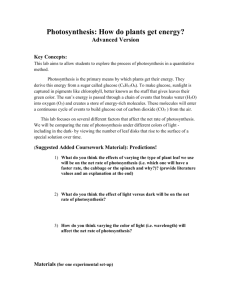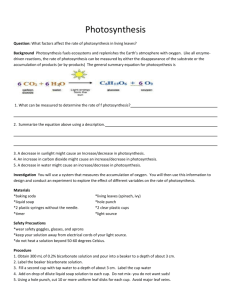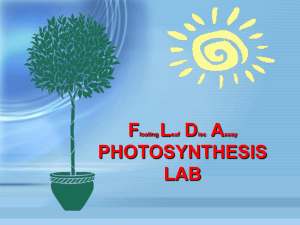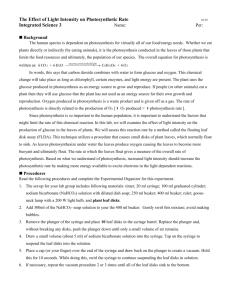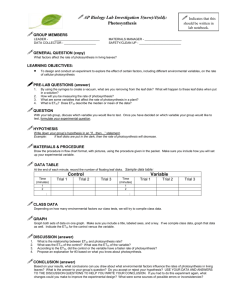Lab 5: Photosynthesis
advertisement
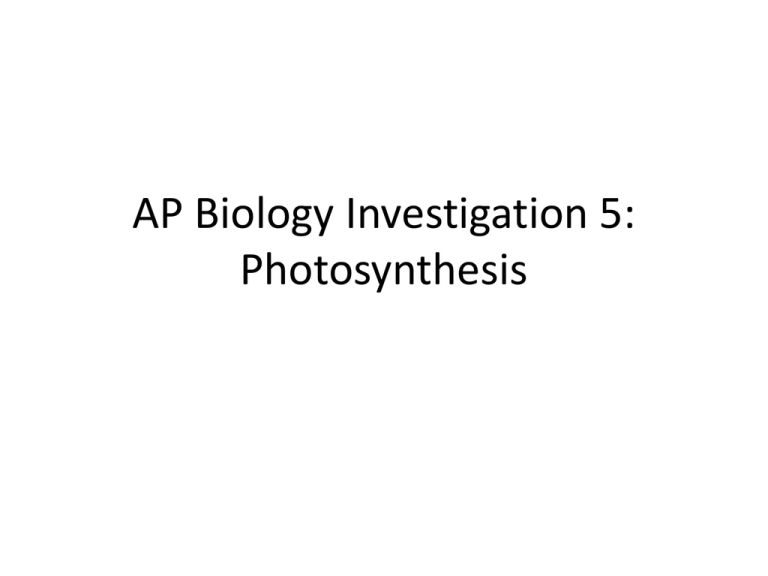
AP Biology Investigation 5: Photosynthesis Lab Notes • General summary equation for photosynthesis: 2H2O + CO2 + light carbohydrate (CH2O) + O2 + H2O • Ways to measure the rate of photosynthesis: – Production of O2 – Consumption of CO2 • In this lab, we will use a system to measure the accumulation of oxygen • Spongy mesophyll layer of leaves normally infused with gases (O2 and CO2) • Leaves will normally float in water Floating Leaf Disk Technique • Draw gases from leaves using a vacuum and replacing gases with water • Sunken leaves placed in solution with source of carbon dioxide (sodium bicarbonate) • Photosynthesis occurs in leaves oxygen accumulates leaves become buoyant and rise in the water • Rate of photosynthesis measured indirectly by rate of rise of the leaf disks Materials Procedures 1. Label 2 cups: “With CO2” and “Without CO2” – With CO2: pour 0.2% sodium bicarbonate (NaHCO3) solution into plastic cup to a depth of about 3 cm – Without CO2: distilled water (control) Procedures 2. Add 1 drop of dilute liquid soap into each cup – Soap acts as a surfactant or “wetting agent” – Wets hydrophobic surface of leaf, allowing solution to be drawn into leaf enabling leaf disks to sink in fluid Procedures 3. Using hole punch (or plastic straw), punch out 10 uniform leaf disks for each cup. – Avoid major leaf veins Procedures 4. Draw gases out of leaves and infiltrate with solution (either with or without CO2) a) Remove plunger from syringe. Place 10 leaf disks into each syringe barrel. Tap to put disks at bottom of syringe. b) Carefully replace plunger. Push down close to leaf disks. c) Draw small volume (~ 5 cc) of solution into syringe. Tap to suspend disks in solution. Invert and expel excess air from syringe. d) Create a vacuum in plunger using finger to draw air out of leaf tissue. – Hold finger over syringe draw back plunger 10 sec swirl tube to resuspend disks release – Repeat 2-3 times to get all disks to sink (No more than 3+ times! Damage to disks can occur.) 5. Pour disks and solution from syringe into appropriate cup. – Disks infiltrated with sodium bicarbonate go into “With CO2” cup – Disks infiltrated with distilled water go into “Without CO2” cup 5. Place both cups under light source and start timer. 6. Record # floating disks at the end of each minute. – Swirl disks to dislodge any that stick to sides of cups. – Continue until all disks are floating in “With CO2” cup Analysis • Need standard point of reference to make comparisons • ET50 = Estimated Time it takes 50% of leaf disks to float • Graph data determine ET50 from graph – ET50 = time it takes for half the disks (5) to float # floating leaf disks Time (minutes) Class Data Comparison of ET50 across treatments • Inverse relationship: ET50 decreases as rate of photosynthesis increases (negative slope) • To correct this representation, graph the inverse (1/ET50) vs. rate of photosynthesis Brainstorm What are some factors that could affect photosynthesis? Inquiry Investigation • • • • • • Problem (choose a specific factor to test) Experimental Design (IV, DV, control, contants, etc.) Hypothesis (If…, then…. because….) Materials Procedure (flowchart) Data Table – Record # floating disks each minute until all disks are floating Analysis and Conclusion • Analysis – Determine ET50 (estimated time it takes 50% of disks to float) – Graph lab group data – Class data • Conclusion (use Explanation Tool)

